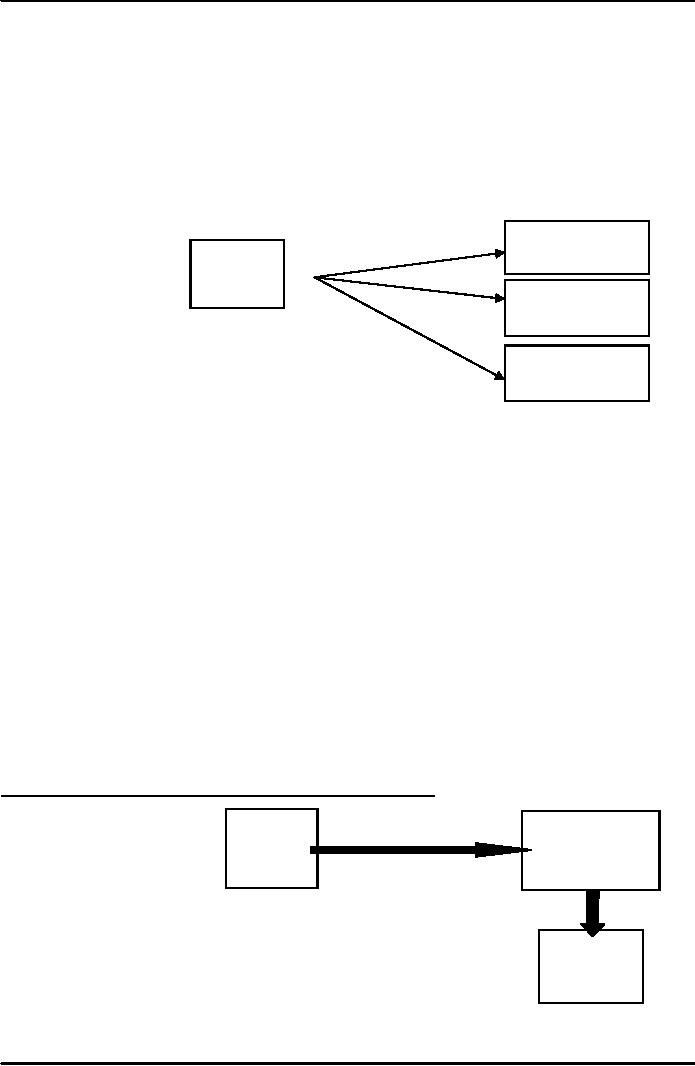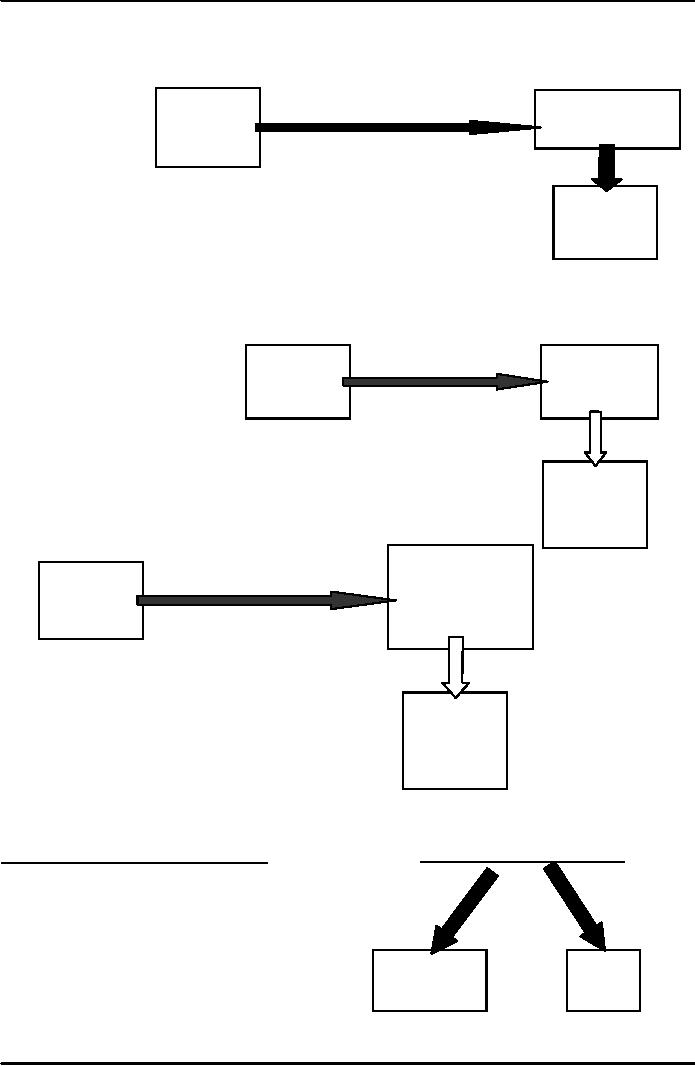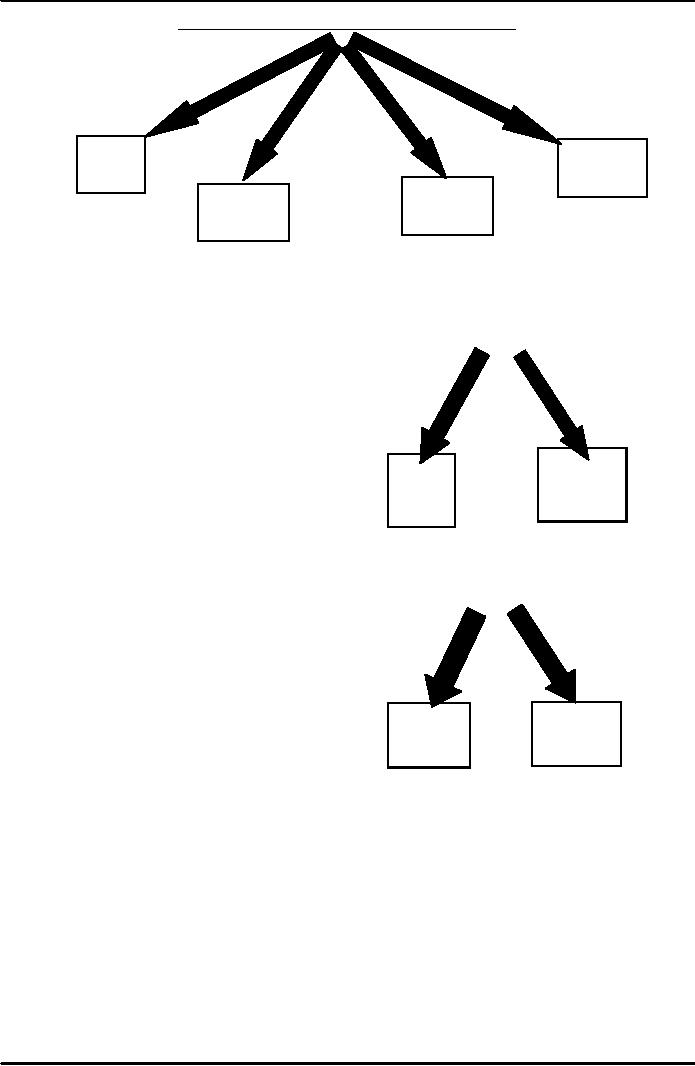 |

Introduction
to Psychology PSY101
VU
Lesson
21
OPERANT
CONDITIONING
�
Type
of learning in which a voluntary response
becomes stronger or weaker depending on
its
positive
or negative consequences.
�
The
organism plays an active
role and `operates' on
environment to produce the
desired
outcome.
Operant
conditioning forms an
association between a behavior
and a consequence.
Consequences
have to be immediate, or clearly
linked to the behavior. With verbal
humans, we can explain
the
connection between the consequence and
the behavior, even if they are
separated in time. For
example,
you
might tell your friends that
you'll buy dinner for them
since they helped you move, or a parent
might
explain
that the child can't go to
summer camp because of her
bad grades. With very young
children,
humans
who don't have verbal
skills, and animals, you
can't explain the connection between
the
consequence
and the behavior. For the
animal, the consequence has to be
immediate.
Four
Possible Consequences
There
are four possible
consequences of any behavior:
Something
Good can start or be
presented
Something
Good can end or be taken
away
Something
Bad can start or be
presented
Something
Bad can end or be taken
away
Applying
these terms to the Four
Possible Consequences
�
Something
Good can start or be
presented: behavior increases
=
Positive Reinforcement
(R+).
�
Something
Good can end or be taken
away: behavior decreases
=
Negative Punishment
(P-).
�
Something
Bad can start or be
presented: behavior decreases
=
Positive Punishment
(P+).
�
Something
Bad can end or be taken
away, so behavior increases
=
Negative
Reinforcement
(R-).
Thorndike's
Law of Effect
Any
response leading to an outcome
that is satisfying for the
organism is likely to be repeated; a
response
leading
to an outcome that is not
satisfying is not likely to be
repeated.
Association
by Contiguity
�
The
organism forms an association or connection
between the response and
its
consequences.
For it to be effective, the response and
the outcome have to be
closely
linked__
both in time and
space.
�
The
theory drew attention
towards the significance of reward
and punishment in learning
new
behavior.
Criticism
against Thorndike's Approach
It
was not clear about what exactly
`satisfying' meant
Some
points to ponder
Have
you ever thought?
�
Why
do teachers give silver and gold
stars on children's workbooks?
�
Why
do horses gallop faster when the
rider whips them?
�
Why
do parents allow children to
watch cartoons when they finish
their homework in
time?
�
Why
do we find surprise gifts in the packs of
detergents?
�
Why
do employees who earn profit
to the organization get a bonus at the
end of year? And,
�
Why
do children show temper
tantrums in the presence of guests
even when they know
the
mother
is going to scold and
punish?
The
answers to all these
questions can be found in the
operant conditioning
approach
Burrhus
Frederic Skinner:
1904-1990
126

Introduction
to Psychology PSY101
VU
�
American
Psychologist and the founder of
Operant Conditioning.
�
His
theory is somewhat similar to
Thorndike's, but it was
actually Watson who
impressed him.
The
Typical procedure in Skinner's Operant
conditioning experiments
�
A
special apparatus usually
known as skinner's box is
used.
�
Laboratory
animals learn to press a lever so
that food is delivered to
them.
�
The
environment is controlled.
�
The
animal operates on the environment,
and as a result of its
behavior it may be rewarded
or
punished.
Food is the reward.
�
The
consequence determines if the response
will be repeated or
not.
Consequences
of Behavior
Positive
Behavior
consequence
Negative
consequence
No
consequence
Consequences
of Behavior; Reinforcement
Reinforcement
is used for increasing the
probability that the preceding
behavior will be
repeated
through
a stimulus. Also some
consequences may deter the re
occurrence of behavior. Reinforcement
can
be
in the form of:
�
Positive
reinforcement
�
Negative
reinforcement
Other
consequences may be:
�
Punishment
�
No
reinforcement
Reinforcer
�The
stimulus that increases the
probability of repetition or re
occurrence of a behavior
�It
can be material as well a
non material in nature.
Positive
Reinforcer/ Reward
It
is a stimulus whose introduction brings
about an increase in the preceding
response.
CONSEQUENCES
OF BEHAVIOR AND THEIR IMPACT
Positive
Response
reinforcement
Response
will
be
repeated
127

Introduction
to Psychology PSY101
VU
Negative
Rein forcer
�A
stimulus whose removal reinforces
and leads to a higher likelihood
that the response bringing
about this
removal
will be repeated: in simpler
terms it means repeating a
behavior in order to get rid
of a negative
stimulus.
Negative
Response
Reinforcement
Response
will
be
Repeated
Punishment
Punishment
is an unpleasant or painful stimulus
whose introduction following a
certain behavior
decreases
the
likelihood that the behavior
will occur again.
Response
Punishment
Response
will
not be
No
reinforcement
Repeated
This
also deters or stops a
behavior from being
repeated.
No
Response
Reinforcement
Response
will
not be
repeated
Schedules
of Reinforcement
�The
procedures involving specific
frequency and timing of
reinforcing
a desired behavior
Schedules
of Reinforcement
SCHEDULES
OF REINFORCEMENT
Continuous
Versus Partial
Schedules
Continuous
Schedule
Reinforcing
the behavior every time it is
repeated.
Continuous
Partial
Partial
Schedule
The
behavior is reinforced but not
every time.
128

Introduction
to Psychology PSY101
VU
PARTIAL
SCHEDULES OF REINFORCEMENT
Fixed
Fixed
Ratio
Interval
Variable
Variable
Interval
Ratio
PARTIAL
SCHEDULES OF REINFORCEMENT CONSIDERING
THE FREQUENCY OR
NUMBER
OF RESPONSES
Fixed
Ratio Schedule
The
organism is reinforced only after a
specific number of
responses
is made e.g. salary after 7
days.
Variable
Fixed
Variable
Ratio Schedule
Ratio
Ratio
The
organism is reinforced after a varying number
of
responses
is made (not a fixed number)
e.g. surprise
bonus.
PARTIAL
SCHEDULES OF REINFORCEMENT CONSIDERING
THE PERIOD OR
AMOUNT
OF TIME
Fixed-
Interval Schedule
The
organism is reinforced after pre fixed
time intervals e.g.
giving
students a candy every two
days.
Variable-
Interval Schedule
Variable
Fixed
The
organism is reinforced after around an average
time
Interval
Interval
interval
instead of fixed ones e.g.
at times giving 2
candies
after
6days, and one after two
days.
Remember!!!
Immediate and appropriate reinforcement is essential
for learning.
Consistency
is the golden rule; follow the pattern of reinforcement regularly
and never let the
organism
feel
that his/her/its behavior is
not been observed and the
progress not
followed.
The
most effective schedule of
reinforcement is the variable-interval
schedule.
Shaping
�
Successive
approximations of a required/-desired response
are reinforced until that
response is fully
learnt:
�
In
the beginning each and every
success is reinforced with a reward, no
matter how small the
success.
�
Once
the desired response is learnt the
reinforcer immediately follows it,
every time it happens.
�
Once
learnt the behavior, in many cases, the
organism may not need
reinforcement since many
behaviors
are self-reinforcing e.g. learning to play a
musical instrument.
129

Introduction
to Psychology PSY101
VU
Stages
in Shaping
Acquisition:
Initially
the response rate following reinforcement
may be slow but at one
stage it increases to
the
maximum-----acquisition.
Extinction:
If reinforcement is
withheld the response rate
decreases and finally no
response is shown------
extinction.
Shaping
Can Best Be Used
For
�Learning
alphabets, vocabulary, mathematical
tables,
or a new language.
�Learning
to play a musical Instrument.
�Appropriate
classroom behavior.
�Training
mentally handicapped children.
Behavior
Modification
�A
therapeutic/intervention strategy used
for modifying behavior in
such a manner that the
frequency of
desired
behavior is increased up to the optimal
level, and the frequency of undesired
behavior is brought
down
to the minimum...or to extinction
level.
�The
intervention is based upon the operant
principles of learning.
Steps
in Behavior Modification
�Identification
of goals in terms of target
behavior.
�Recording
the preliminary/background information
concerning the behavior in
question.
�Designing
the intervention, issues involved,
and deciding its components.
�Implementation
of the planned program as well as careful
monitoring.
�Recording
the events, progress, and
problems during the implementation
phase.
�Evaluating
the program and making alterations if
required.
Token
Economy/ Token
System:
�The
person is rewarded with some
form of a token every time a
desired behavior is
exhibited.
�The
token can be play money/token or a
chip representing money; it
can be the silver or gold stars
earned
by
the child; parents can give
different colored paper tokens
for good behavior.
�After
a specific number of tokens have
been earned, they can be
exchanged for something
desirable.
Contingency
Contracting
�A
written contract is held between the
client and the therapist,
specifying all goal-behaviors as
well as
consequences;
parents and teachers can
also use it.
�The
contract is followed strictly no matter if the
consequences of behavior are
negative, and the client
may
in
fact dislike them; the purpose is to
promote target behavior e.g.
if an over-eater fails to refrain
from
confectionary
throughout the week, he will
have to send a donation
cheque for drinks in a marathon;
the
cheques
are prepared at the beginning of the
program.
Who
is Operant Conditioning Most Effective
with?
�Children
�Animals
�Mentally
handicapped
Applications
of Operant Conditioning in Real Life
Situations
�
Child
rearing.
�
Classroom
management.
�
Teaching of
skills.
�
Animal
taming.
130

Introduction
to Psychology PSY101
VU
�
Advertising.
�
Psychological
intervention and Psycho-
therapy: behavior modification,
assertiveness training,
and
token
economy.
Child
Rearing
Things
to remember:
�If
you make rules, stick to
them; if you can not
stick to them then don't
make rules.
�Provide
immediate reinforcement as promised.
�Consider
no reinforcement along with positive/
negative reinforcement and punishment.
Classroom
Management
�In
different situations positive/negative
reinforcement, punishment, and no reinforcement
work.
�The
same rules apply as is in child
rearing.
Significant
results in case of:
�
Discipline
�
Memorization
e.g. learning tables
�
Vocabulary
�
New
skills
Shaping
procedures are of special
help in classroom
settings.
Organizational
Behavior
�Fixed
wages after a fixed period or variable
wages depending on performance have
different effects in
different
situations.
Psychotherapy/care
for special needs/health
psychology
�More
effective when combined with cognitive
approach for:
�Children
with special needs.
�Quitting
smoking or alcohol.
�Weight
reduction programs.
�Compliance
with medical advice.
How
do many youngsters start
taking drugs?
�Operant
conditioning principles operate here
too. What positively
reinforces addictive behavior can
be
the:
�Free
offers.
�The
subsequent effect.
�Peer
acceptance.
Weight
Reduction Programs
Following
can be of help:
�Contracts
�Allowing
one's self to eat favorite
food once a week
Learning
Healthy Lifestyles
Acquiring
better skills for improving
and enhancing health can be
made easier by using learning
techniques.
131
Table of Contents:
- WHAT IS PSYCHOLOGY?:Theoretical perspectives of psychology
- HISTORICAL ROOTS OF MODERN PSYCHOLOGY:HIPPOCRATES, PLATO
- SCHOOLS OF THOUGHT:Biological Approach, Psychodynamic Approach
- PERSPECTIVE/MODEL/APPROACH:Narcosis, Chemotherapy
- THE PSYCHODYNAMIC APPROACH/ MODEL:Psychic Determinism, Preconscious
- BEHAVIORAL APPROACH:Behaviorist Analysis, Basic Terminology, Basic Terminology
- THE HUMANISTIC APPROACH AND THE COGNITIVE APPROACH:Rogers’ Approach
- RESEARCH METHODS IN PSYCHOLOGY (I):Scientific Nature of Psychology
- RESEARCH METHODS IN PSYCHOLOGY (II):Experimental Research
- PHYSICAL DEVELOPMENT AND NATURE NURTURE ISSUE:Nature versus Nurture
- COGNITIVE DEVELOPMENT:Socio- Cultural Factor, The Individual and the Group
- NERVOUS SYSTEM (1):Biological Bases of Behavior, Terminal Buttons
- NERVOUS SYSTEM (2):Membranes of the Brain, Association Areas, Spinal Cord
- ENDOCRINE SYSTEM:Pineal Gland, Pituitary Gland, Dwarfism
- SENSATION:The Human Eye, Cornea, Sclera, Pupil, Iris, Lens
- HEARING (AUDITION) AND BALANCE:The Outer Ear, Auditory Canal
- PERCEPTION I:Max Wertheimer, Figure and Ground, Law of Closure
- PERCEPTION II:Depth Perception, Relative Height, Linear Perspective
- ALTERED STATES OF CONSCIOUSNESS:Electroencephalogram, Hypnosis
- LEARNING:Motor Learning, Problem Solving, Basic Terminology, Conditioning
- OPERANT CONDITIONING:Negative Rein forcer, Punishment, No reinforcement
- COGNITIVE APPROACH:Approach to Learning, Observational Learning
- MEMORY I:Functions of Memory, Encoding and Recoding, Retrieval
- MEMORY II:Long-Term Memory, Declarative Memory, Procedural Memory
- MEMORY III:Memory Disorders/Dysfunctions, Amnesia, Dementia
- SECONDARY/ LEARNT/ PSYCHOLOGICAL MOTIVES:Curiosity, Need for affiliation
- EMOTIONS I:Defining Emotions, Behavioral component, Cognitive component
- EMOTIONS II:Respiratory Changes, Pupillometrics, Glandular Responses
- COGNITION AND THINKING:Cognitive Psychology, Mental Images, Concepts
- THINKING, REASONING, PROBLEM- SOLVING AND CREATIVITY:Mental shortcuts
- PERSONALITY I:Definition of Personality, Theories of Personality
- PERSONALITY II:Surface traits, Source Traits, For learning theorists, Albert Bandura
- PERSONALITY III:Assessment of Personality, Interview, Behavioral Assessment
- INTELLIGENCE:The History of Measurement of Intelligence, Later Revisions
- PSYCHOPATHOLOGY:Plato, Aristotle, Asclepiades, In The Middle Ages
- ABNORMAL BEHAVIOR I:Medical Perspective, Psychodynamic Perspective
- ABNORMAL BEHAVIOR II:Hypochondriasis, Conversion Disorders, Causes include
- PSYCHOTHERAPY I:Psychotherapeutic Orientations, Clinical Psychologists
- PSYCHOTHERAPY II:Behavior Modification, Shaping, Humanistic Therapies
- POPULAR AREAS OF PSYCHOLOGY:ABC MODEL, Factors affecting attitude change
- HEALTH PSYCHOLOGY:Understanding Health, Observational Learning
- INDUSTRIAL/ORGANIZATIONAL PSYCHOLOGY:‘Hard’ Criteria and ‘Soft’ Criteria
- CONSUMER PSYCHOLOGY:Focus of Interest, Consumer Psychologist
- SPORT PSYCHOLOGY:Some Research Findings, Arousal level
- FORENSIC PSYCHOLOGY:Origin and History of Forensic Psychology